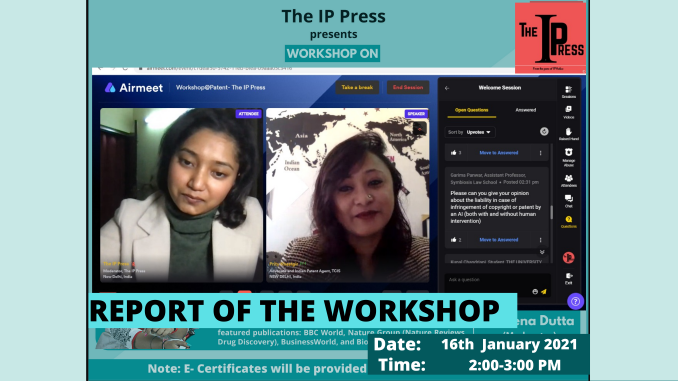
Topics: Future of Cross-licensing to Create Patent Pool; The fate of AI-based Innovations; Future perspectives of a career in IPR
The Workshop on Future of Cross-licensing to Create Patent Pool; The fate of AI-based Innovations; Future perspectives of a career in IPR started at 1:50 PM IST on 16th January 2021 by the Moderator Teena Dutta with a welcome speech followed by a video introduction to The IP Press. The delay of twenty minutes in starting the workshop was unfortunately faced by everyone due to the technical glitches. Nevertheless, the moderator, Teena, thereafter didn’t look back and gave a strong start to the workshop with the introduction of the speaker Advocate Prity Khastgir.
Adv. Prity Khastgir initiated the session with a PowerPoint presentation (Click here to access) on AI and IPRs which consist of the following:
- Agenda of the workshop: AI & IPRs, Creating Patent Pool and, Opportunities in IPRs.
- Statistics on Patenting Landscape of AI.
- Artificial Intelligence, Machine Learning, Deep Learning.
- Applications of Machine Learning
- Artificial Intelligence and Copyright
- Artificial Intelligence and IPRs
- Patent Pool
- Opportunities in IPR and sustainable development goals.
Here are the key takeaways from the workshop:
- Following statistics on the patenting landscape of AI were shown:
(i) The term Artificial Intelligence (AI) was introduced in the year 1956. However, patenting in the field of AI was significantly increased in the year 2020.
(ii) Notably, the USA leads the patenting charts in the field of AI.
(iii) Moreover, names like Samsung, LG, Microsoft, etc. were seen as the major applicants in the said category. - In the like manner, the topic, “Statistics on Patenting Landscape of AI in India” was also discussed, wherein it was identified that patent applications on AI 2018 were mostly published in 2018 and the number then kept on increasing.
- The workshop took off to the most compelling question, what is AI? The term was defined with the help of an interactive illustration of the workshop’s platform, Airmeet.
- Machine Learning and Deep Learning are subsets of AI. To quote: “AI is usually perceived as a synonym for deep supervised machine learning.” To enumerate,
(i) Input Data is fed to Machine,
(ii) This data is then processed using various algorithms and parameters (Machine Learning) and
(iii) structured and trained data is produced as an Output.
Here AWS, Android, and IOS are major data miners. The speaker showed patent application drawings to clarify the AI’s mimic behaviour. - Artificial Intelligence & Copyright:
(i) Decision on the authorship of a copyrighted work created by AI is a grey area that is still under discussion. As per experts, an author must be a natural person/ human.
(ii) A great stress was laid on a new artwork generated by a computer with the example of The Next Rembrandt by the 17th-century Dutch artist Rembrandt Harmenszoon van Rijn. - Patents and AI:
(i) AI algorithms could only be protected by introducing a new dimension in software patenting, i.e., the speaker emphasized the importance of technical effect in the AI-implemented inventions for patenting.
(ii) Discussion on the recognition of rights of inventorship in AI-implemented inventions under the patent law. - The speaker talked about the concept of Patent Pool. She discussed that companies must decide the best between assignment, licensing, joint venture, and franchising, to implement a patent pool. Likewise, essential and non-essential patents were described. Certainly, the patent pool is necessary as it creates a win-win situation for all. Further, pooling resources are necessary as “execution is important than perfection”.
- The speaker also discussed sustainable development goals and how they are an opportunity for the upcoming generation of IP enthusiasts.
Then the attendees posed a variety of questions as follows:
- Can two different AI-Based Product, whose output is similar, can be patented or Copyright?
- How has Fend Allani’s decision impacted possible Al patents? Also, the technical effect/advancement concept may be elaborated on from a practical perspective?
- What are the job opportunities for students in the AI industry?
- Can trade dress be used to legally protect software UIs? As you mentioned about copyright, whether trade dress mechanism is better suited to protect the overall look and feel of Uls?
All questions including the above were patiently answered by Advocate Prity Khastgir.
After the Q&A session, the moderator Teena Dutta asked Advocate Prity Khastgir for any advice that she wants to give to the IP aspirants. She suggested everyone take up volunteering opportunities in the UN as it will allow them to learn from case studies and encourage them to be interactive. Further, law students who are interested in working in the field of AI should consider pursuing AI & ML courses. “Think out of the box”, she added.

Leave a Reply